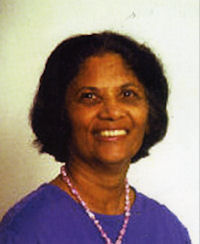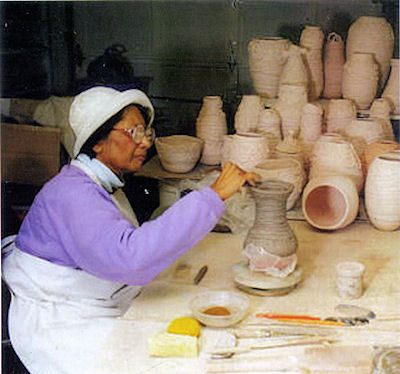Trinidadian born artist Vera Baney is a study in resilience.
Orphaned at the age of two, denied a fundamental education, she
continued to strive to improve herself over the years. This self-taught artist,
whose experimental work using local clays has had a profound impact
on the local and regional art community, has pieces in several private and
public collections across the globe. She continues to work, although suffering
a severe stroke which paralysed her left side, and lives with fellow
artist and husband Ralph, in Maryland, USA. A recipient of the national
Hummingbird Medal (Gold) medal, she was recently honoured by
The University of the West Indies, St. Augustine Campus.
STAN is pleased to present the Graduation speech delivered by
her son at the 2007 Ceremony.
At the opening of my (1967) exhibition in San Fernando, the late President of Trinidad and Tobago, Justice Noor Hassanali, said " there are three art organizations in Trinidad: there is the Trinidad Art Society, the Southern Art Society and then there is Ralph and Vera Baney". Mrs. Hassanali who is in the audience will remember that.
That acclaim did not come easily. I had my fair share of hardships. My life has been, and still is, a life of challenges and adversity. I feel that the subject of adversity is what I am best qualified to speak to you about.
I was orphaned at the age of two and grew up in the house of an aunt and uncle in Duncan Village. The most outstanding thing about this experience was that I was the Cinderella in the house and watched my six cousins, two of them girls, attend high school without similar benefit to myself. I only heard about Naparima Girls High School, which I wanted so much to attend.
I did very well in elementary school. I was skipped a class and wanted to take the pupil teachers exam which would have qualified me to go into teaching. My aunt put her foot down and said no.
As a teenager the only education I was able to get was evening classes at the YMCA in San Fernando. Here I learnt how to use my hands to make crafts. And here I met and made lifelong friends with Ena Bridgelal and Ruby Crichlow who are in the audience today. Life has its adversities, but it also has its rewards.
|

When I was sixteen it became necessary to leave my aunt's and uncle's house. Among the people who helped to uplift me were Rev. and Mrs. Roy Neehall who at that time lived in Penal. They were very supportive of me during this period of transition. They appreciated me and made me feel like a member of their family - a connection I maintain to this day with their children. Yet another of life's compensation(s) for earlier adversity.
Ralph and I had a friendship going on. We got engaged before we went to England on one year study leave. He came back and was off again on a five year art scholarship, but this time we made plans for me to join him. We were both penniless but we had dreams and in time we made the dreams come true. I joined him after three years. Some people had been taking bets that the long distance relationship would not end in marriage.
I took a job and worked by day and took craft classes at night. On weekends we went to art shows and had a wonderful time as poor students.
"I paid my tuition fees from the
sale of my pots.
I never gave up
hope that some day I would be
able to get an education."
continued>> |
|
 I remember Ralph would spend his last 60 cents to buy me flowers and would say I was well worth it. His flowers are a little bit more expensive nowadays. We returned to Trinidad penniless. Ralph had a job to go back to and 1 was a stay at home housewife.
I remember Ralph would spend his last 60 cents to buy me flowers and would say I was well worth it. His flowers are a little bit more expensive nowadays. We returned to Trinidad penniless. Ralph had a job to go back to and 1 was a stay at home housewife.
At that time my biggest challenge was to create a job for myself. Ralph taught pottery
at the Southern Art Society. I saw an opportunity to try something new. Pottery
took over the kitchen table and I got input from
Ralph when he came home from work. Soon we were digging clay from different parts of the island and carrying out tests. Then I was experimenting with local materials for making glazes. I found all these to be totally absorbing and absolutely fascinating. I was using humble materials from the ground that we walked on as my raw material and transforming them into unique and useful objects.
I had to learn from books. I made it a point to invest about four hundred dollars a year in ceramics books so that I could look at the best and latest work being done by the best clay artists in the world. I found ceramics to be challenging, frustrating, satisfying and rewarding.
I realized that the reason why nobody else was doing ceramics in Trinidad was because of the numerous problems involved. In order to solve some of these problems, Ralph and I attended a summer school at the College of Ceramics at Alfred University in upstate New York. It marked the turning point in my creative work. On our return Ralph built a new kiln and wheel which allowed me to move forward with my work. I followed ceramics with a passion. The more I worked, the more the ideas flowed.
But I still yearned for a high school education, even at a more mature age. Ralph was accepted to the University of Maryland to study for the Master of Fine Arts degree. I did the GED or High School equivalent. So, finally I got the education that I missed when I was younger. I then signed up at the University of Maryland, from where I graduated with a Bachelor's degree, with a Major in Studio Art. I paid my tuition fees from the sale of my pots. I never gave up hope that some day I would be able to get an education. And life balance the past yet again.
In 1999 we were poised for producing art and having shows when I had a stroke. When I regained consciousness in the hospital, the first thing that came to my mind was our son Clarence and that I had to stay alive for him. Clarence was the gift that made me fight for my life. It was a severe stroke which meant a lot of readjustment in our lives. I did everything that the doctors told me to do. I tried to find ways of continuing to work with clay. I was left handed and now my left side was paralysed. Consequently, I started training myself to use my right hand. I made it a point to go to the studio five days a week for about forty-five minutes each time. When I gained mastery of controlling the clay again, I challenged myself to make bigger pots or to do sculpture...The stroke has been the most difficult adversity I have had to overcome, but I am still working at it and I live a fulfilling life....You live in an exciting age and you are a select group of people. Quite unlike my situation, you have opportunities. Many of you are privileged. Your education empowers you to explore and to go much further. Your journey is now beginning and the sky is the limit...
VERA BANEY

